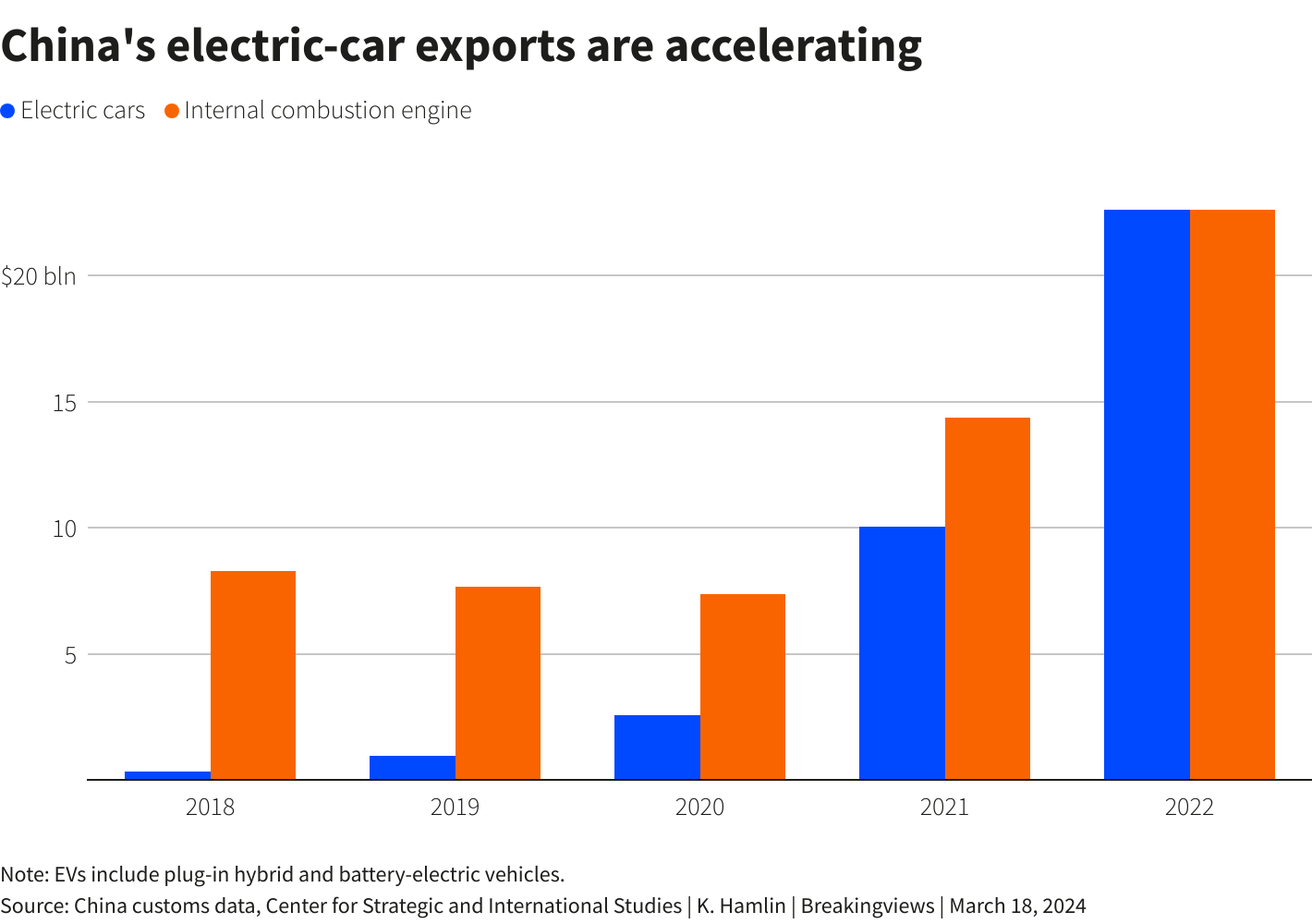The Growing Influence Of Chinese Automakers On The World Stage

Table of Contents
Technological Advancements Driving Chinese Automotive Growth
China's rise in the automotive sector isn't just about quantity; it's about a technological leap forward. The country's commitment to innovation is evident across several key areas, propelling Chinese car brands to the forefront of the global automotive market.
Electric Vehicle (EV) Dominance
China leads the world in electric vehicle production and battery technology. Government incentives, substantial investments in research and development, and a robust charging infrastructure have created a fertile ground for the growth of Chinese electric vehicle brands.
- Successful Chinese EV Brands and Models: BYD's Han and Tang models, NIO's ET7 and ES8, and Xpeng's P7 are just a few examples of successful electric vehicles making waves internationally.
- Government Incentives: Generous subsidies and tax breaks have significantly boosted EV adoption within China, creating economies of scale that benefit manufacturers.
- Advancements in Battery Technology: Chinese companies are at the forefront of battery innovation, developing high-density batteries with longer ranges and faster charging times.
- Charging Infrastructure Development: China has invested heavily in building a comprehensive network of charging stations, addressing a major hurdle for widespread EV adoption.
Autonomous Driving Technologies
China is also making significant strides in autonomous driving technology. Collaborative efforts between automakers and tech giants are fueling rapid advancements in artificial intelligence (AI) and sensor technology, paving the way for self-driving Chinese cars.
- Autonomous Features in Chinese Cars: Many new Chinese vehicles boast advanced driver-assistance systems (ADAS), including adaptive cruise control, lane-keeping assist, and automated parking.
- Investment in AI and Sensor Technologies: Massive investments in research and development are driving improvements in AI algorithms and sensor technology crucial for autonomous driving capabilities.
- Collaborations with Tech Giants: Partnerships between Chinese automakers and tech companies like Baidu and Tencent are accelerating the development and deployment of autonomous driving systems.
- Regulatory Frameworks: While still evolving, China is actively developing regulatory frameworks to support the safe and responsible deployment of autonomous vehicles.
Connectivity and Digital Features
Chinese automakers are integrating advanced infotainment systems and connectivity features into their vehicles, providing drivers with seamless connectivity and a personalized driving experience.
- In-Car Connectivity Features: Many models offer Wi-Fi hotspots, over-the-air software updates, and smartphone integration through Apple CarPlay and Android Auto.
- Integration with Smartphones and Smart Homes: Chinese automakers are exploring ways to integrate their vehicles with smart home ecosystems, allowing for remote control of various functions.
- Use of AI Assistants: AI-powered virtual assistants are becoming increasingly common in Chinese cars, providing voice-activated control over various vehicle functions.
- Over-the-Air Software Updates: This feature allows for continuous improvements and new features to be added to the vehicle after purchase, enhancing the overall user experience.
Aggressive Global Expansion Strategies of Chinese Automakers
The success of Chinese automakers isn't just limited to the domestic market; they're aggressively expanding their global footprint, employing various strategies to penetrate international markets and build brand recognition.
Market Penetration Tactics
Chinese automakers are utilizing a multi-pronged approach to enter and compete in international markets.
- Successful Market Entry Strategies: Strategies include focusing on specific niche markets, offering competitive pricing, and establishing strategic partnerships with local distributors.
- Pricing Models to Undercut Competitors: In some markets, Chinese automakers are leveraging their cost advantages to offer vehicles at lower prices than established competitors.
- Strategic Alliances with Foreign Companies: Collaborations with established automakers or technology companies provide access to new markets, technologies, and distribution networks.
- Acquisitions of Existing Car Brands: Acquisitions of established brands can provide immediate access to distribution channels, manufacturing facilities, and brand recognition.
Building Brand Recognition and Trust
Building trust and brand recognition in international markets is a crucial challenge for Chinese automakers.
- Marketing Campaigns Targeting Specific Regions: Tailored marketing campaigns highlight the unique features and benefits of Chinese vehicles to resonate with different cultural contexts.
- Celebrity Endorsements: Using prominent celebrities to endorse their brands helps build recognition and improve consumer perception.
- Emphasis on Quality and Safety: Investing in quality control and safety features is vital to addressing concerns and building consumer confidence.
- Participation in International Auto Shows: Participating in international auto shows provides a platform to showcase their latest models and interact with potential customers.
Focus on Emerging Markets
Chinese automakers are also focusing their expansion efforts on rapidly growing emerging markets.
- Specific Examples of Emerging Markets: Countries in Southeast Asia, South America, and Africa are key target markets for Chinese automakers.
- Tailoring Models to Local Needs and Preferences: Adapting vehicle designs and features to meet the specific needs and preferences of consumers in different regions is crucial.
- Establishing Manufacturing Plants in These Regions: Establishing local manufacturing facilities helps reduce transportation costs, improve responsiveness to local demands, and foster local economic development.
Challenges Faced by Chinese Automakers in the Global Arena
Despite their rapid growth, Chinese automakers still face significant challenges in the global automotive market.
Overcoming Brand Perception
One major hurdle is overcoming pre-existing negative perceptions about the quality and reliability of Chinese-made products.
- Addressing Concerns Related to Quality, Safety, and Technology: Demonstrating consistent quality and safety through rigorous testing and robust after-sales service is paramount.
- Implementing Strategies to Improve Brand Image: Investing in marketing and public relations initiatives to highlight advancements in technology and build positive brand associations is essential.
Navigating Global Trade Regulations
Navigating complex trade regulations and tariffs in different countries presents another challenge.
- Specific Trade Barriers Faced by Chinese Automakers: Tariffs, import restrictions, and non-tariff barriers can significantly impact the competitiveness of Chinese vehicles in certain markets.
- Impact of Geopolitical Factors: Geopolitical tensions and trade wars can create uncertainty and disrupt supply chains.
- Strategies to Overcome Regulatory Hurdles: Proactive engagement with regulatory bodies and strategic partnerships can help mitigate the impact of trade barriers.
Competition from Established Automakers
Competition from established international car manufacturers remains a significant challenge.
- Strategies to Differentiate Products and Compete on Price, Features, and Brand Reputation: Offering competitive pricing, innovative features, and focusing on building a strong brand reputation are crucial for success.
Conclusion: The Future of Chinese Automakers on the World Stage
The rise of Chinese automakers is undeniable. Their technological advancements, particularly in the electric vehicle sector, coupled with aggressive global expansion strategies, are reshaping the international automotive landscape. While challenges remain, their focus on innovation, emerging markets, and competitive pricing positions them for continued growth. The future will likely see Chinese automakers playing an increasingly prominent role in the global automotive industry, influencing technology trends, market dynamics, and the overall consumer experience. Stay informed about the latest developments in the global automotive industry and the continued rise of Chinese automakers by subscribing to our newsletter!

Featured Posts
-
 Hollywood Production Grinds To Halt Amidst Joint Writers And Actors Strike
Apr 26, 2025
Hollywood Production Grinds To Halt Amidst Joint Writers And Actors Strike
Apr 26, 2025 -
 Chainalysis Acquisition Of Alterya A Strategic Move In Ai And Blockchain
Apr 26, 2025
Chainalysis Acquisition Of Alterya A Strategic Move In Ai And Blockchain
Apr 26, 2025 -
 Abb Vie Abbv Higher Profit Forecast Driven By New Drug Performance
Apr 26, 2025
Abb Vie Abbv Higher Profit Forecast Driven By New Drug Performance
Apr 26, 2025 -
 From Scatological Data To Engaging Podcast The Power Of Ai
Apr 26, 2025
From Scatological Data To Engaging Podcast The Power Of Ai
Apr 26, 2025 -
 Stock Market Outlook Dow Futures Chinas Economic Policies And Trade Uncertainty
Apr 26, 2025
Stock Market Outlook Dow Futures Chinas Economic Policies And Trade Uncertainty
Apr 26, 2025
